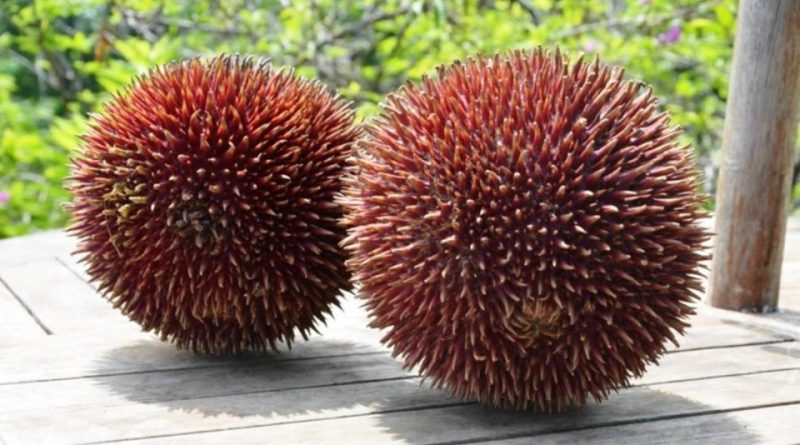Durio dulcis
Durio dulcis
The marangang durian, red durian, tutong or lahong (Durio dulcis Becc.) is an arboreal species belonging to the Bombacaceae family.
Systematics –
From a systematic point of view it belongs to:
Eukaryota domain,
Kingdom Plantae,
Magnoliophyta division,
Class Magnoliopsida,
Subclass Dilleniidae,
Malvales Order,
Bombacaceae family,
genus Durio,
D. dulcis species.
The term is synonymous:
– Durio conicus Becc..
Etymology –
The term Durius comes from durian (or durion), the Malay vernacular name for the thorny fruit of this genus of plants (from the Malay duri thorn).
The specific epithet dulcis comes from sweet, suave, attractive, pleasant, delightful.
Geographic Distribution and Habitat –
Durio dulcis is a plant endemic to Borneo and present in Southeast Asia, Malaysia and Indonesia.
Its habitat is that of the mixed lowland Dipterocarpaceae forest, at altitudes up to 800 metres, where it grows in the wild on sandy clayey soils and friable clayey loam.
Description –
Durio dulcis is a tree that can grow up to 40 meters in height.
The trunk can reach up to 80 cm in diameter and large buttresses up to 4 meters high.
The leaves are ovoid-lanceolate in shape.
The flowers are produced in short inflorescences clustered on older branches.
The fruits are of a variable color, from dark red to a red-brown, with an exocarp covered by spines approximately 15–20 mm long. They are globular in shape with a diameter of up to 15 cm.
The pulp of the fruit is dark yellow in color, with a caramel flavor, with an odor similar to turpentine. The fruit of this species is considered among the sweetest of the Durio genus.
inside there are numerous brown seeds each completely covered by a tasty dark yellow aril.
Cultivation –
Durio dulcis is a tree whose fruit is edible and is harvested from nature and sold in local and urban markets; the species is rarely planted due to its short fruiting period.
The tree is also harvested for its wood.
Logging and forest degradation due to agriculture and logging are major threats to the habitat.
Furthermore, this species suffers from a certain genetic erosion for which this plant has been classified as “Vulnerable” in the IUCN Red List of Threatened Species (2009).
This plant grows in lowland humid tropical areas up to altitudes of 800 meters.
Propagation occurs spontaneously by seed.
Customs and Traditions –
Durio dulcis is a plant whose edible fruits are used. The aril around the seeds is very sweet and fragrant.
It has an attractive deep purplish-red color when fully ripe, with a bright yellow aril that has a smooth, creamy texture and a delicious flavor reminiscent of pineapple cream without the tartness.
The smell is very strong, so much so that these fruits are among the sweetest but also smelly of the kind.
The seeds can be boiled or roasted and then eaten.
No medicinal uses are known.
The wood is durable and used in building interiors, furniture, and packing cases.
The heartwood is pinkish brown in color and the wood is probably one of the most important sources of durian timber in Sarawak (Malaysia).
The wood is relatively strong and is used in interior construction and making cheaper types of furniture and packing cases.
Wood is not durable and does not resist attack by termites; the sapwood is subject to attack by dust beetles. It dries quickly, but thin panels may tend to cup. Wood saws easily and generally dresses softly; the nailing qualities are good.
As said before, this species has been inserted due to the vulnerability of its habitat in the IUCN Red List as vulnerable species.
Method of Preparation –
Durio dulcis is a plant whose fruits are consumed.
The seeds are also eaten after being boiled or roasted.
However, no medicinal uses are known.
Guido Bissanti
Sources
– Acta Plantarum – Flora of the Italian Regions.
– Wikipedia, the free encyclopedia.
– GBIF, the Global Biodiversity Information Facility.
– Useful Tropical Plants Database.
– Conti F., Abbate G., Alessandrini A., Blasi C. (ed.), 2005. An annotated checklist of the Italian vascular flora, Palombi Editore.
– Pignatti S., 1982. Flora of Italy, Edagricole, Bologna.
– Treben M., 2000. Health from the Lord’s Pharmacy, Advice and experiences with medicinal herbs, Ennsthaler Editore.
Photo source:
– https://medialib.naturalis.nl/file/id/L.2370059/format/large
Attention: The pharmaceutical applications and alimurgical uses are indicated for informational purposes only, they do not in any way represent a medical prescription; we therefore decline all responsibility for their use for curative, aesthetic or food purposes.


